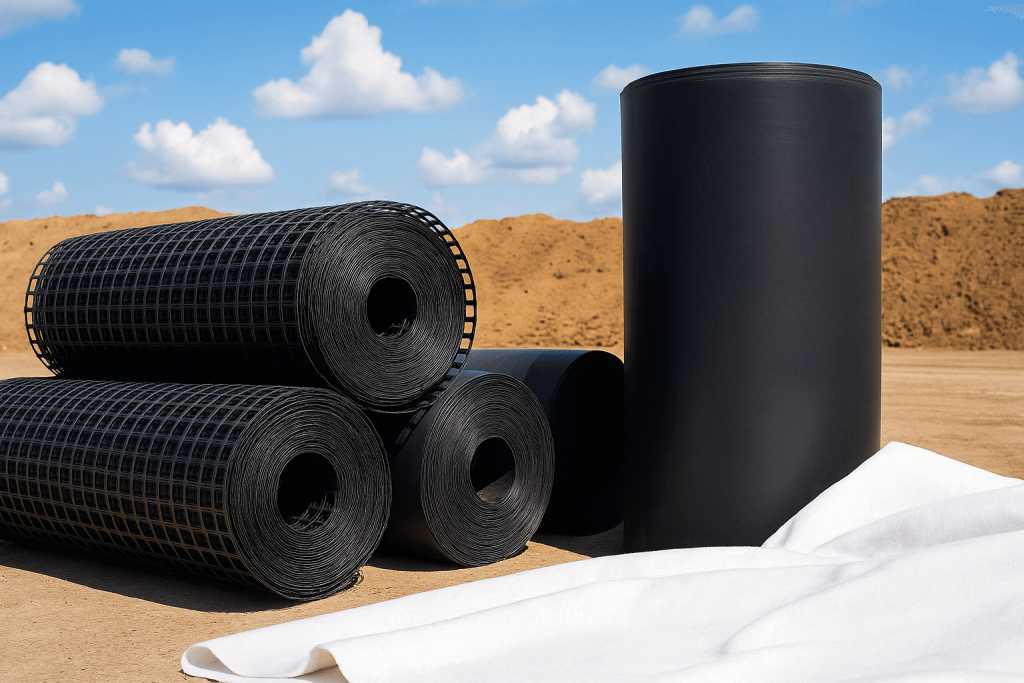
In the face of climate change, rapid urbanisation, and growing demands for sustainable construction, the role of geosynthetics is more critical than ever. These synthetic materials—engineered to stabilise terrain, manage water, and extend the life of infrastructure—have evolved from being practical solutions to becoming innovation drivers across civil engineering and environmental projects.
This article explores the latest trends in geosynthetics, including breakthroughs in geogrids, geomembranes, and geotextiles.
Whether you’re planning large-scale road construction, landfill management, or erosion control systems, understanding these developments can guide better design, cost-efficiency, and environmental responsibility.
Geosynthetics refer to a family of synthetic polymer-based materials used in contact with soil, rock, and other civil engineering materials. Their main functions include:
The most common types include geogrids, geomembranes, geotextiles, geonets, and geocells. Each type serves a specific role in infrastructure and environmental engineering applications.
If you’re new to the topic or need a quick refresher, we’ve covered the fundamentals of what geosynthetics are, including their main types and core functions such as separation, reinforcement, and containment, in our introductory guide here.
This foundation will help you better understand the emerging trends shaping the future of geogrids, geomembranes, and geotextiles in real-world infrastructure and environmental projects.
One of the most important trends is the shift towards eco-friendly and recycled materials in geosynthetic production. With increasing pressure to reduce carbon footprints, manufacturers are developing products using recycled polypropylene (PP) and polyethylene (PE).
Key innovations include:
These solutions are designed to deliver performance without compromising environmental goals—making them suitable for green infrastructure and climate-resilient projects.
Smart geosynthetics incorporate embedded sensors or conductive fibres that allow real-time monitoring of stress, moisture, temperature, and strain. This technology is proving valuable in:
For example, some geomembranes now feature sensor-integrated liners that alert operators to punctures or movement, improving maintenance response and lowering risk.
Geogrids are rapidly expanding in both scale and application scope. Traditionally used for road and railway reinforcement, geogrids are now finding roles in:
High-strength biaxial and triaxial geogrids are enabling faster construction with reduced base material, cutting costs and carbon emissions. New composite geogrids are also being developed with improved bonding to asphalt layers.
Geomembranes remain the go-to barrier system for containment applications like landfills, tailing ponds, reservoirs, and biogas digesters. Emerging trends in geomembranes include:
Additionally, field-welded seams are now tested with automated spark or air-pressure methods for quality assurance, improving installation confidence.
Geotextiles continue to gain popularity due to their versatility in separation, filtration, and reinforcement. In transportation infrastructure, geotextiles reduce maintenance by controlling rutting and water ingress.
Recent improvements include:
The integration of geotextiles into roadbeds and rail embankments enhances pavement performance and extends lifecycle without the need for excessive aggregate.
Another significant advancement is the use of digital tools and simulation software in geosynthetics design. These platforms help engineers:
Programs like PLAXIS, GeoStudio, and FLAC3D are helping designers better understand geosynthetic-soil interaction and optimise material usage.
As extreme weather events become more frequent, geosynthetics are playing a growing role in disaster risk reduction and climate adaptation. Key examples include:
These applications showcase how geosynthetics enable nature-based solutions that are cost-effective, scalable, and fast to implement.
The geosynthetics industry is also witnessing stronger regulatory frameworks and quality standards, which push for higher product consistency and installation excellence.
Key developments:
This growing focus on compliance and traceability strengthens confidence in geosynthetics across project stakeholders.
Type | Function | Key Trends |
Geogrid | Reinforcement | Composite materials, triaxial design, asphalt bonding |
Geomembrane | Containment and barrier | Conductive liners, UV resistance, multilayer designs |
Geotextile | Separation, filtration, drainage | Multi-layered structures, clog-resistant, high-permittivity |
Smart Materials | Monitoring and sensing | Embedded sensors, real-time alerts, remote tracking |
Sustainable Geosynthetics | All functions | Recycled polymers, bio-based inputs, LCA-validated |
The geosynthetics industry is no longer just about providing functional materials for engineering—it’s now shaping the future of sustainable, resilient, and intelligent infrastructure.
From smart geomembranes to digitally engineered geogrids, these materials are redefining what’s possible in road building, environmental protection, and climate adaptation.
As innovation continues, staying updated with the latest technologies and working with experienced partners becomes essential.
Whether you are planning a landfill, a highway, or a flood control system, leveraging the right geosynthetics will be key to long-term success.
🌍 Planning a sustainable infrastructure project?
Partner with an experienced geosynthetics supplier who can guide you on the right materials, latest trends, and cost-effective solutions for long-term performance.
Copyright © Gateway Structure Sdn Bhd (199401025111). All Right Reserved.